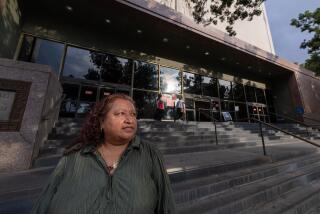Got a Beef? Mediators Help Soothe Festering Disputes
- Share via
Many of the cases sound like candidates for “The People’s Court.” Such as the ones that could appropriately be named “Move Your Fence or I’ll Move Your Face” or “This Apartment’s Not Big Enough for the Two of Us.” Then there was the mother-daughter summer vacation dispute that might well have been titled, “Whose Life Is It Anyway?” And who could forget “Get Your Eugenia Berries Off My White Carpet!”
Those and hundreds of other cases likely would end up clogging local court calendars were it not for a growing and widely praised mediation program that offers a quicker, cheaper alternative to the legal system in settling disputes.
Under action taken by the San Diego County Board of Supervisors last month, the Community Mediation Program, which has proved successful over the past six years within the city of San Diego, will be expanded countywide in an effort to alleviate the backlog of civil cases in Municipal and Superior courts.
Unencumbered by formal courtroom procedures, the mediation program brings people together in an informal, but still structured, hearing intended not so much to determine who is right or wrong as it is to simply settle the disagreement.
“The purpose of mediation isn’t to find the truth--it’s to find a solution,” said Liz Underell, the program’s director. “We don’t think in terms of good guys and bad guys, or victims and guilty parties. Worrying about who’s right or wrong doesn’t move you on--it just keeps you stuck where you are.”
The supervisors’ approval last month of a $300,000 contract will allow the program’s staff of 125 volunteer mediators to be expanded by about 100 mediators by next June, county administrators said. Each mediator will undergo 27 hours of training before being assigned to dispute hearings, which will be held at about two dozen locations throughout the county.
Taking advantage of 1986 state legislation, San Diego County plans to finance expansion of the program through a $3 surcharge on all civil suits filed in local Municipal and Superior courts. The city of San Diego, which has helped to underwrite the program since 1985, also has agreed to contribute $75,000 during the next fiscal year.
Disputes that end up in mediation range from rather mundane squabbles between neighbors--a genre that Underell describes as “your-tree-is-dripping-in-my-pool or your-dog-is-barking-too-loud cases”--to complex complaints involving issues such as construction defects, product liability and labor-management differences. In some, money is only a peripheral issue and the dollar amounts at stake are small, while others involve settlements reaching hundreds of thousands of dollars.
However, Charles Wiggins, a law professor at the University of San Diego, where a prototype of the mediation program was developed in 1983, cautions against dismissing any of the seemingly minor mediation cases as trivialities that simply indulge individuals’ hardheadedness and litigious instincts by providing a quasi-legal forum to air petty differences.
“Some of these cases are trivial only in monetary terms, not in emotional terms,” Wiggins said. “If you’re involved, it’s very important to you. In fact, in some ways, it’s more important for people to find ways to get along with their next-door neighbors than it is for companies to make decisions involving huge amounts of money.”
Although no dollar limits are imposed upon mediation cases, many of the disputes are ones that otherwise would be destined for small claims courts or that, if they never reached the courthouse--for economic or other reasons--could produce lingering enmity, if not physical violence, among neighbors, tenants and landlords or customers and businesses.
Many of the Mediation Center’s cases, in fact, stem from referrals from small claims court officials, who inform individuals intending to file a suit of the alternative.
“When people call us for the first time, they think we’re Judge Wapner or something like that,” Underell joked, referring to the judge who presides over TV’s “People’s Court.”
Consistently loud music, barking dogs, overgrown shrubbery or visually intrusive fences along property lines, house expansions that block a neighbor’s view, rental security deposit arguments, dissatisfaction with auto repairs or consumer purchases--these and other everyday occurrences form a large percentage of the disputes that go before the mediators.
San Diego lawyer Jerry Harris said that resolving commonplace disputes via mediation can reduce local courts’ logjams--a major reason why many judges have embraced the concept.
Cases Won’t Just Go Away
“These cases aren’t going to just go away,” said Harris, a member of the Community Mediation Center’s advisory board. “If they aren’t settled this way, the courts probably will have to deal with them. And in many of these cases, that’s in no one’s best interest.”
Similarly, Supervisor Brian Bilbray, a strong advocate of the mediation program, argues that it “prevents small disputes from escalating into large ones . . . without resorting to judicial overkill.”
“So-called minor disputes between neighbors can turn into very ugly situations where people get hurt,” Bilbray said. “Before mediation, if you couldn’t settle the problem yourself, your only option was going to court. Mediation lowers the intensity of the process to reflect the intensity of the problem.”
Last year, the mediation program resolved about 800 disputes involving nearly 1,900 people, according to Judy Foland, the Mediation Center’s program coordinator. While most disputes heard by the center involve only two people, mediators have heard cases involving as many as 50 people. With the program’s staffing level now scheduled to nearly double, a commensurate increase in the caseload is expected next year.
Although estimates on the extent to which mediation has lessened court caseloads are imprecise--in part because of the uncertainty that any threatened lawsuit will ever actually go to court--Presiding Superior Court Judge Michael Greer feels that the impact has been significant.
“We’re seeing less and less of these family dispute-type cases, which makes it possible for us to use our limited resources better,” Greer said. “When judges realize there are (major cases) needing attention, it’s frustrating to have to handle disputes over whether one person did or did not punch someone else, whether a fence is two inches over a property line and which side the fruit falls on.”
Agree to Abide by Decision
In a conscious effort to keep mediation proceedings less complicated, time-consuming, intimidating and expensive than court cases, the guidelines governing mediation disputes are kept to a minimum. The only requirements, Underell explained, are that both sides agree to enter mediation and to abide by any compromise reached.
That latter provision, however, is more of a voluntary oath than a binding pledge because the mediation agency has no legal authority to enforce it. Despite that fact, follow-up calls to mediation participants show that about 86% abide by the mutually agreed-upon resolution.
“I think when people are part and parcel of settling a dispute, they’re more supportive of the decision,” Underell said.
Characterizing mediation as a no-lose proposition, its proponents note that individuals unable to reach a settlement reserve the option of going to court. On occasion, mediators suspect that some people involved in disputes use the mediation as a trial run for a court proceeding to get a sense of how a neutral third party reacts to their arguments. Such instances of “coming into the process in bad faith,” however, are rare, Underell said.
A mediation session itself is described by USD law professor Wiggins as “a little more than a casual chat . . . but a lot less threatening than a courtroom.” Typically lasting about two hours, the meetings give both parties--who appear, more often than not, without attorneys--an opportunity to air their grievances and to offer proposed solutions, with the mediator playing a role that is equal parts moderator, compromiser and devil’s advocate.
Of the disputes that are settled, nearly 95% are resolved during the first mediation session, Underell said. Some problems, however, require multiple sessions that, on occasion, stretch into double digits.
Finding Common Ground
Wanting to be perceived as neither judge nor jury, mediators usually resist offering solutions themselves, preferring to nudge the principals into finding acceptable common ground. That formula, mediation officials believe, is largely responsible for the program’s high success rate. Unlike court cases, which produce clear winners and losers, mediation is designed to allow each side to walk out feeling satisfied.
“In mediation, people have a much stronger hand in shaping decisions than they do in court,” mediator Marty Arnold said. “They don’t just sit back while lawyers do most of the talking. And the resolution isn’t imposed on them--it comes from them.”
In adherence with mediation’s guiding tenet, the dispute resolutions usually are based more on simple common sense--a commodity often lost amid long pent-up hard feelings--than precise legalities or factual analyses.
That approach is illustrated by the eugenia tree case, which occupies an honored place in local mediation lore. In that case, the dispute focused on an overgrown eugenia tree between two yards--the yard belonging to an older couple in which the tree grew and the yard of a young couple that had recently redecorated their house by installing a white carpet.
Tiring of tracking eugenia berries in on their new carpet, the young couple repeatedly asked their neighbors, without success, to trim back their tree. As the situation dragged on, mutual animosity grew faster than the eugenia. Finally, they agreed to enter mediation, where the dispute was quickly defused by the younger couple agreeing to help their older neighbors--who explained that they had trouble reaching the top of the tree--trim the eugenia.
Many other cases end with such logical, simple solutions.
A mother’s insistence that her daughter stay home during summer vacation to baby-sit her younger sister was resolved, for instance, when the older daughter--who initially wanted to be free to spend time with her friends whenever she chose to--agreed to take her sister with her if she left the house. Another dispute over division of monthly bills between two roommates led to their admission to the mediator that the problem was not the bills, but rather that they intensely disliked each other--a confession that led to an amicable decision to part their ways. Property line and fence disputes often are settled with a minimum of expense and inconvenience to both parties.
“A lot of the answers are simple things you’d think people could work out between themselves,” lawyer and mediation adviser Harris said. “Unfortunately, many of these people have stopped talking or are so suspicious of each other that they need someone else to help them discuss it.”
Despite its impressive track record, Underell cautions that the mediation program--like any effort to resolve differences--does not ensure that “everyone ends up friends--or even friendly.”
“But most times, they feel satisfied because they know they’ve really had their say and someone listened to them,” Underell said. “That’s really what a lot of people are looking for in these cases.”
More to Read
Sign up for Essential California
The most important California stories and recommendations in your inbox every morning.
You may occasionally receive promotional content from the Los Angeles Times.













